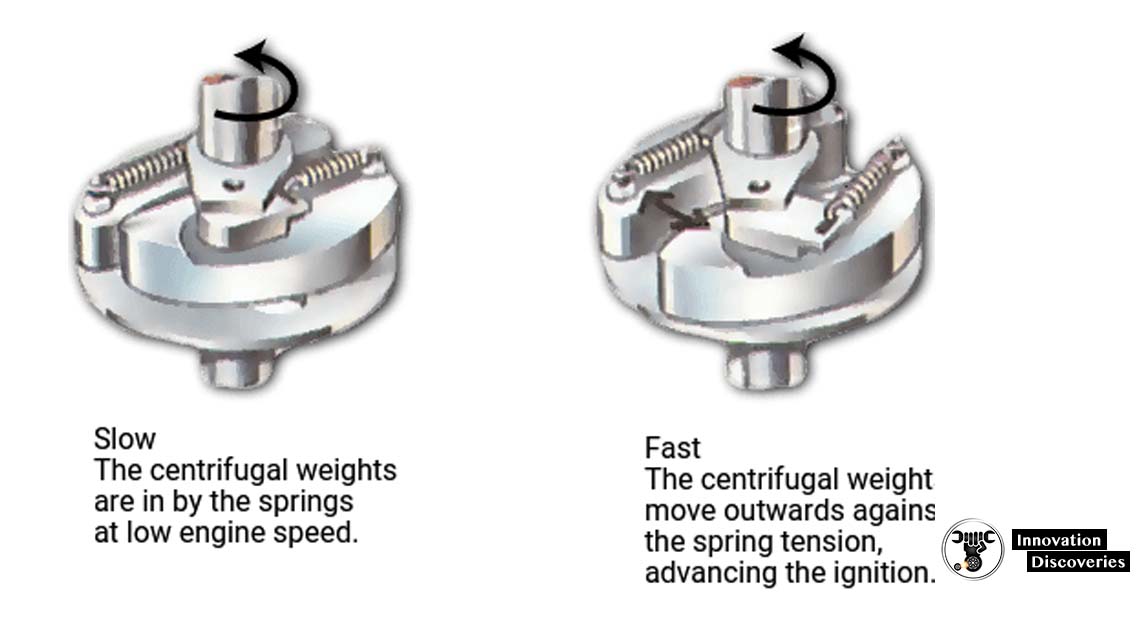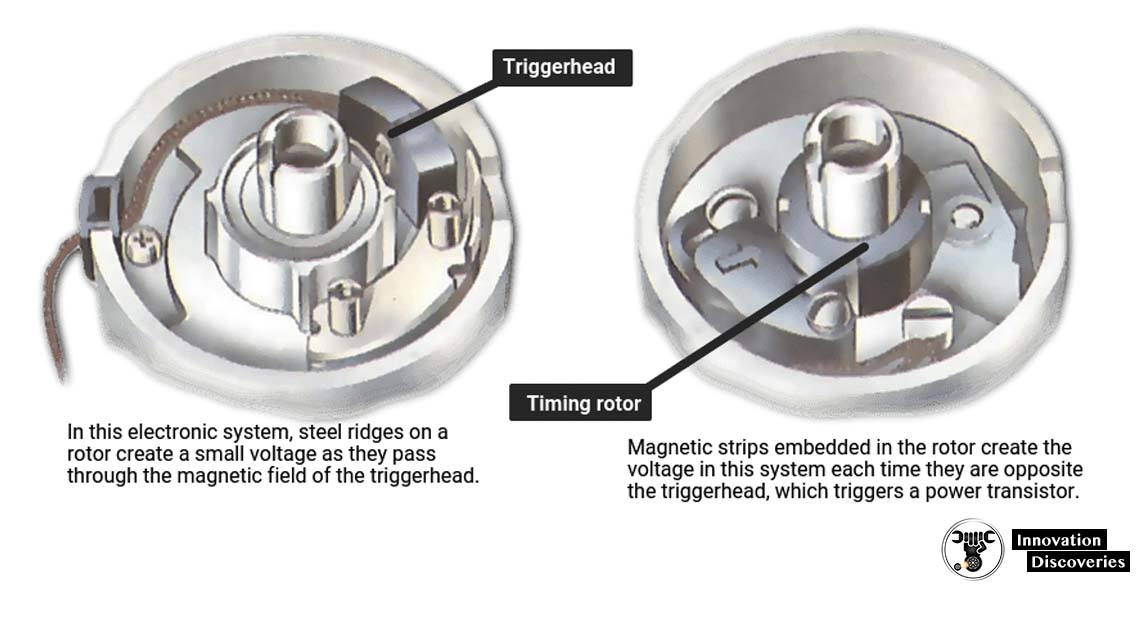For an engine to work at its best, the fuel /air mixture in each cylinder
Must fire just as the piston reaches top dead centre ( TDC ).
It takes a certain time for the spark-plug to ignite the
Mixture and for the combustion to build up.
This time stays roughly the same no matter how fast the engine is running
The timing mechanism is set to fire the plug a short time before the TDC.
But because the mechanism is worked by the motion of the engine,
This time would normally decrease as the engine ran faster,
And the plug would fire too late.
So a mechanical device is fitted to advance firing
Make it happen earlier – with increasing engine speed.
The load on an engine – whether it is pulling hard or cruising also affects the timing.
A lightly loaded engine works best if the ignition is advanced an extra amount.
A second vacuum-operated device controls this independently of the first.
Distributor

The distributor both sends the HT current to the correct sparkplug and
Ensures that it arrives at the best time for maximum efficiency.
For an engine to work at its best, the fuel /air mixture in
Each cylinder must fire just as the piston reaches the top dead centre ( TDC ).
It takes a certain time for the
Spark-plug to ignite the mixture and for the combustion to build up.
This time stays roughly the same no matter how fast the engine is running.
The timing mechanism is set to fire the plug a short time before the TDC.
But because the mechanism is worked by the motion of the engine,
This time would normally decrease as the engine ran faster,
And the plug would fire too late.
So a mechanical device is fitted to advance firing make it happen earlier
With increasing engine speed.
The load on an engine – whether it is pulling hard or cruising,
Also, affects the timing.
A lightly loaded engine works best if the ignition is advanced an extra amount.
A second vacuum-operated device controls this independently of the first.
Centrifugal advance mechanism
The centrifugal advance mechanism responds to engine speed.
It is usually in the bottom of the distributor body
Under the contact-breaker baseplate.
Two steel weights are attached to a revolving plate on the
Distributor shaft by pivots,
And held in the closed position by strong springs.
As the engine speeds up, the centrifugal force throws the weights outwards.
They turn on their pivots,
Twisting the contact-breaker cam forwards so that the points open earlier,
And the spark plug fires earlier as the speed increases.
How the centrifugal weights work

Vacuum advance mechanism

The vacuum advance mechanism responds to the
Vacuum in the engine inlet manifold,
Which is caused by the suction of the moving pistons.
When the engine is lightly loaded the vacuum increases.
A narrow pipe runs from the manifold to a vacuum chamber on the distributor, Inside which there is a flexible diaphragm.
As the vacuum increases, the diaphragm bends,
Moving a rod connected to its centre which causes the
Contact-breaker baseplate to swivel slightly.
This moves the contact-breaker heel relative to the distributor cam and
Advances the ignition.
When the engine is under load, vacuum decreases,
The diaphragm springs back and the ignition is retarded to suit the changed conditions.
Adjusting the timing
The usual way of adjusting the timing is to slacken the
Clamping bolt of the distributor and turn the whole unit slightly.
The amount by which the two advance mechanisms change the timing is not adjustable.
Some earlier distributors have a knurled nut on the vacuum advance mechanism,
By which you can alter the timing as a whole
(not just the action of the mechanism).
How electronic ignition works
Many newer cars have an electronic ignition system
Which times the spark more precisely than a mechanical system.
It also wears less, so that it is always at peak efficiency,
And it overcomes one problem of a mechanical system
at high engine speeds, a mechanical system does not work at peak efficiency.
Electronic systems may be of the inductive discharge or capacitive discharge type.
An inductive discharge system is the type usually fitted as,
Original equipment on cars with electronic ignition.
It produces high-tension (HT) current in the normal way
By switching low-tension (LT) current off and on in a coil.
In the simplest inductive discharge system,
The transistor-assisted contacts (TAC) type, there is also a normal contact breaker.
It carries only a very small current,
Which is fed to a power transistor which switches on and off the heavier LT current to the coil.
The contact-breaker points are not eroded by the small current,
So they stay clean for longer, and the gap seldom needs resetting.
More advanced,
Fully electronic systems may not have points.
Instead, The distributor contains another form of triggering device for the power transistor which relies on electrical pulses instead of a
Mechanical make-and-break method.
In one type there is an electromagnetic coil and a revolving
Spiked rotor with one steel spike for each cylinder.
Every time a spike moves past the coil it creates a small voltage
Which triggers the transistor.
Some other types may have optical or magnetic triggers
They all perform the same function.
A capacitive discharge (CD) system used in some do-it-yourself kits produces
HT current in the coil by sending a large pulse from a capacitor through the primary winding.
The capacitor is an electrical storage device that can be charged and discharged very rapidly.
The secondary winding of the coil produce
HT current both at the moment when the LT current in the primary winding is switched on,
And at the moment it is switched off.
Because a capacitor can give a very large pulse very fast,
There is always a strong spark, irrespective of the speed of the engine.



9 Comments